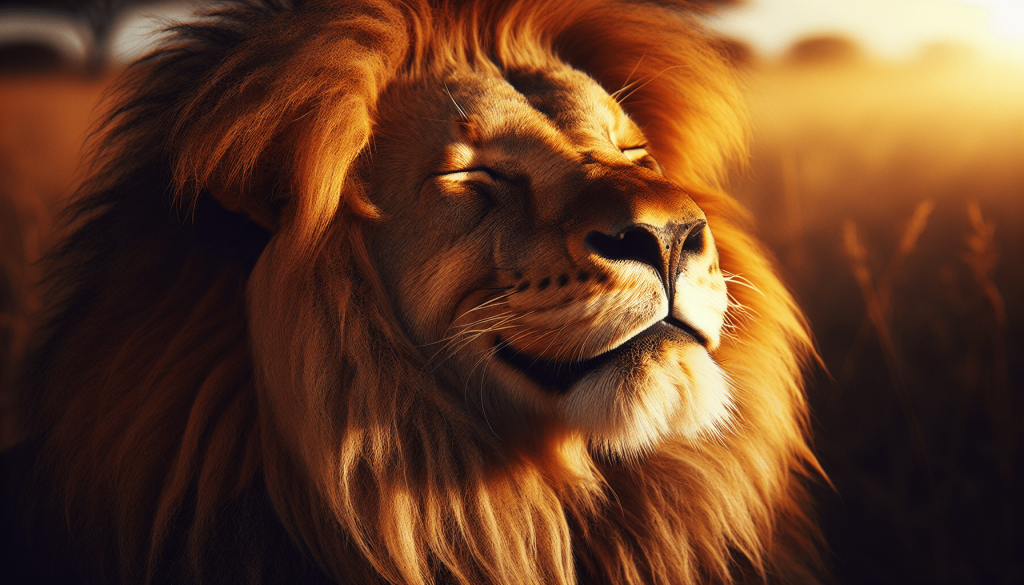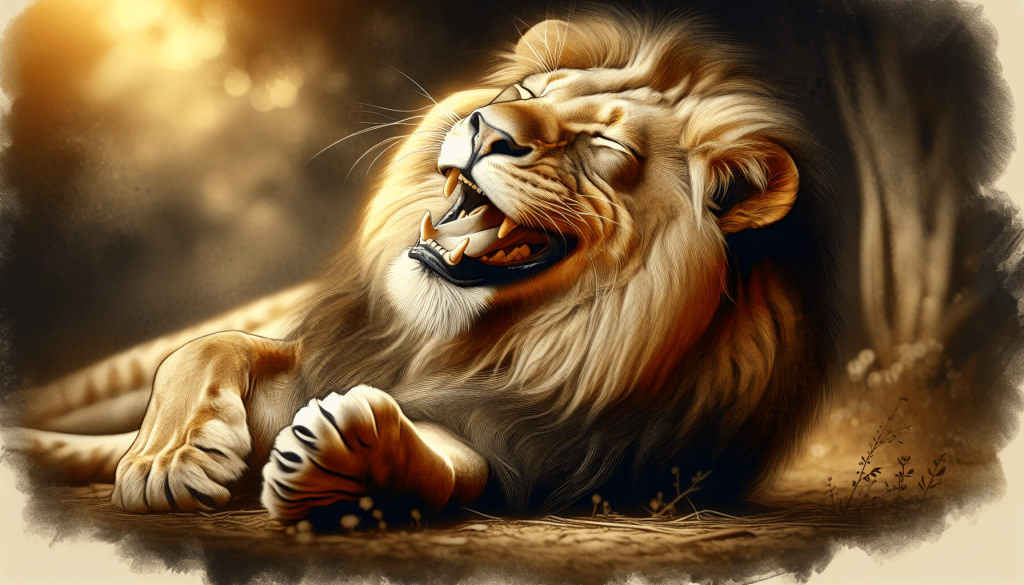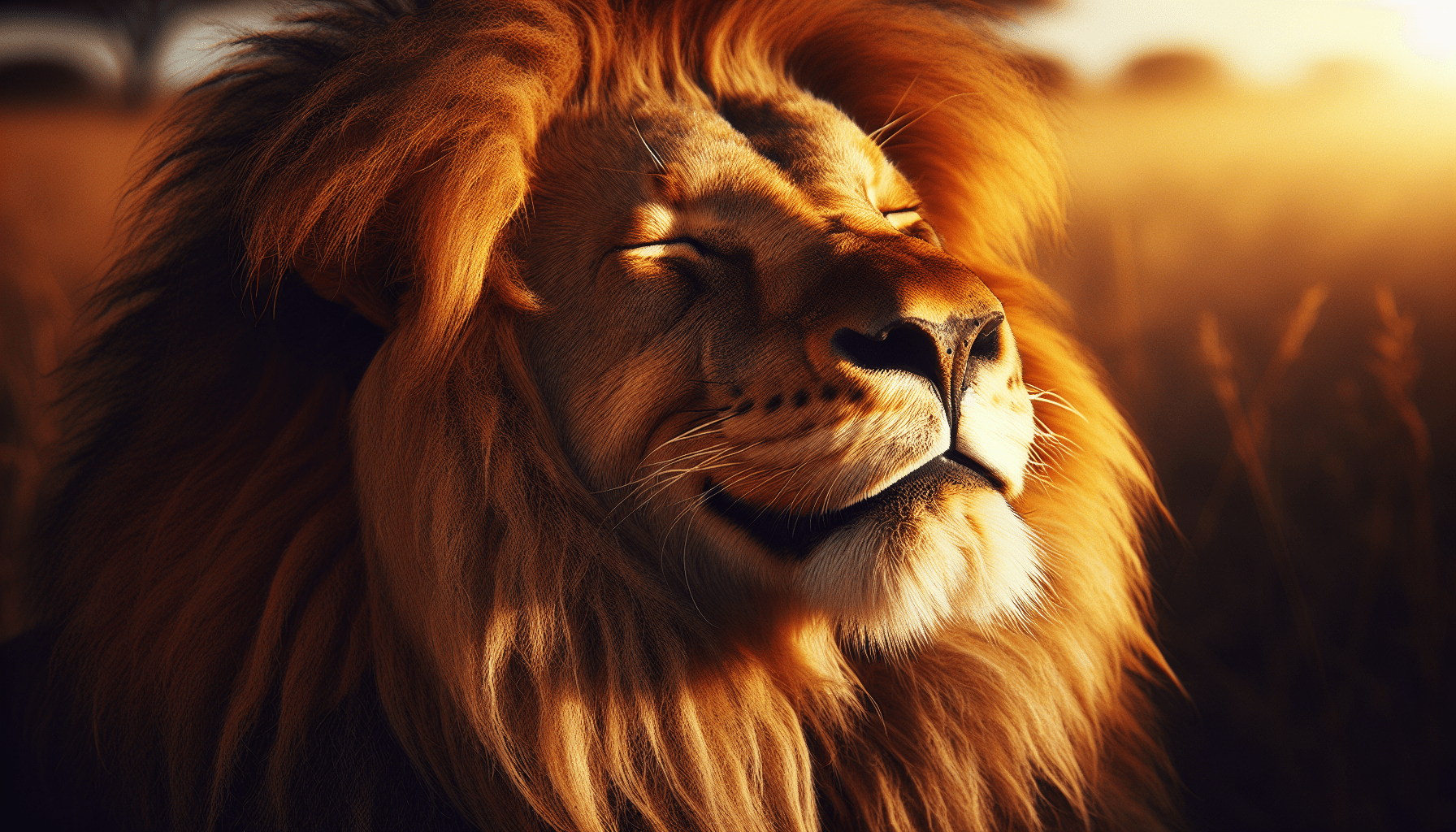So you’re curious about what lions do when they’re happy, huh? Well, they might not throw parties or break out in giggles like humans do, but these majestic creatures have their own unique ways of expressing contentment. From purring like giant cats to engaging in playful behaviors, lions show their happiness in ways that would make anyone’s heart skip a beat. Get ready to learn more about the fascinating world of lion behavior and uncover some adorable secrets about how these kings and queens of the savannah celebrate their happiness.
Physical Signs of Happiness
When lions are feeling happy and content, they often exhibit a variety of physical signs. One common indicator is tail flicking. Lions will flick their tails back and forth in a rhythmic manner, almost as if they are wagging their tails like a domestic dog. This tail flicking is a way for lions to release tension and show their relaxed state.
Another physical sign of happiness in lions is purring. Just like your house cat at home, lions will purr when they are feeling content and at ease. The deep rumbling sound can be heard from a distance and is a clear indication that a lion is in a state of happiness.
Additionally, lions will often rub against objects in their environment to mark their territory and show their contentment. They will rub their scent glands, located on their faces and bodies, against trees, rocks, or anything they come across. This behavior not only leaves behind their scent for other lions to recognize, but it also serves as a form of self-grooming, which can further increase their sense of well-being.
Playful Behavior
When lions are in a playful mood, they engage in various activities that are both entertaining to watch and indicative of their happiness. Play fighting is a common behavior among lion cubs and young adults. They wrestle with each other, testing their strength and agility, all while maintaining a friendly and non-aggressive demeanor.
Chasing each other is another playful behavior lions often engage in. They will take turns being the chaser and the one being chased, sprinting across open spaces and relishing in the thrill of the pursuit. This activity not only provides physical exercise but also fosters social bonds within the pride.
Pouncing is yet another playful behavior that lions exhibit. Whether it’s pouncing on a fallen branch or on fellow pride members, this behavior allows them to hone their hunting skills and indulge in some lighthearted fun. All of these playful behaviors serve as important outlets for their energy and enhance their overall sense of happiness and fulfillment.

Social Interactions
Lions are highly social animals, and their interactions with one another play a crucial role in their overall happiness. One way lions express their affection and cement social bonds is through grooming. They use their rough tongues to groom each other’s fur, removing dirt and parasites. This behavior not only promotes cleanliness but also strengthens their social connections and provides a sense of belonging within the pride.
Head rubbing is another form of social interaction commonly observed among lions. They will rub their heads against each other, showing affection and reinforcing family bonds. This behavior also helps in the exchange of scent, as lions have scent glands on their faces that allow them to mark each other with their unique scent profiles.
Vocalizations play a significant role in lion social interactions as well. Lions communicate with each other through a wide range of vocalizations, including roars, grunts, and meows. These vocalizations serve as a means of expressing emotions, seeking attention, or coordinating group activities. Hearing the familiar sounds of their pride members can bring about a sense of happiness and reassurance among lions.
Stretching and Relaxing
Just like humans, lions also engage in stretching and relaxation behaviors to maintain their physical and mental well-being. Yawning is a common behavior observed among lions, and it serves as a way for them to wake up and prepare for their daily activities. A well-earned yawn can indicate that a lion is feeling relaxed and content.
Rolling on their backs is another behavior lions exhibit when they are feeling at ease. By exposing their vulnerable belly, lions are able to release tension and demonstrate their trust and relaxation within their environment. This behavior is often seen during periods of rest or following a successful hunt.
Lions also adopt lazy postures, where they sprawl out or rest in comfortable positions. Their bodies become loose and limp, showcasing their complete relaxation. These postures not only help lions to conserve energy but also reflect their overall state of contentment and happiness.

Showing Affection
When lions are feeling affectionate, they display a range of behaviors that showcase their love and care for one another. Nuzzling is a common behavior observed among lions, where they press their faces against each other or against other parts of their body. This gentle act conveys feelings of warmth, comfort, and camaraderie.
Lions also express affection through licking. They use their rough tongues to groom and lick their pride members, showing their care and devotion. Licking is often observed among lion cubs, who receive maternal care through this mutual grooming behavior.
Resting close to each other is yet another way lions demonstrate their affection. Whether it’s lying side by side or curling up together, physical proximity allows lions to feel a sense of security and belonging within their pride. This closeness fosters strong social bonds and contributes to their overall happiness.
Exhibiting Contentment
When lions are content, their body language and facial expressions provide clear indications of their emotional state. One physical sign of contentment in lions is closed eyes. When a lion relaxes and closes its eyes, it shows that it feels safe and secure in its surroundings.
Relaxed facial muscles are another indicator of lion contentment. A lion with a relaxed face will have soft, droopy features, without any signs of tension or aggression. Facial expressions can vary among individual lions, but a content lion generally exhibits a serene and amiable countenance.
Reduced tension in the body is also a telltale sign of lion contentment. A lion at ease will have relaxed muscles, with no signs of stiffness or stress. Their movements become fluid and effortless, further reinforcing their emotional well-being.
Engaging in Playful Activities
Lions, despite their majestic and powerful presence, also engage in playful activities that bring joy and excitement to their lives. Swimming, although not as commonly observed as in some other animal species, is a playful behavior that some lions partake in. Whether it’s wading in shallow water or taking a leisurely swim, lions can enjoy the coolness and freedom of movement that water provides.
Climbing trees is another playful activity that lions sometimes engage in, particularly when they are younger and more agile. Whether it’s for exploration or to escape from the heat of the ground, climbing trees allows lions to challenge themselves physically and expand their territory vertically.
Tug of war is a popular game among lions, especially when playing with their siblings or fellow pride members. They will playfully grip and pull on objects like branches or carcasses, showcasing their strength and competitiveness in a friendly context. These playful activities not only provide entertainment but also help lions to develop their coordination, strength, and problem-solving skills.
Feeding Behaviors
Feeding time is a significant event for lions, and certain behaviors during meals can indicate their happiness and satisfaction. Purrs while eating are commonly heard among lions. Similar to their purring when content, purring while eating signifies a state of relaxation and contentment, as they enjoy their meal.
Tail wagging is another behavior often observed during feeding. Lions may wag their tails back and forth as they consume their prey, expressing their excitement and pleasure in the food they have obtained. This behavior can also be a way for lions to communicate their enjoyment to other members of the pride.
Playful bites during feeding are another indication of lion happiness. While dining, lions may occasionally engage in gentle bites or nips at each other, as a playful way to assert their position within the pride or to engage in social bonding. These playful interactions further contribute to their overall sense of happiness during mealtime.
Vigorous Exercise
Lions are built for speed and strength, and they often engage in vigorous exercise to maintain their physical well-being. Running at high speeds is a common behavior observed among lions in the wild. Whether it’s during a hunt or as part of play, running allows lions to release pent-up energy, stay fit, and exhibit their athletic prowess.
Jumping and leaping are also prominent exercises for lions. They will jump over fallen logs or leaping from rock to rock, showcasing their impressive agility and coordination. These acrobatic displays serve as both exercise and entertainment, giving lions the opportunity to display their natural abilities.
Stalking toys is another form of vigorous exercise that captive lions often engage in. These toys simulate prey, and lions take on the role of a predator, initiating pursuit and capturing their “prey.” This activity not only provides physical exercise but also stimulates their hunting instincts and keeps their minds active, contributing to their overall happiness.
Relishing in a Comfortable Environment
Creating a comfortable environment is vital for the well-being and happiness of lions. Curling up in the shade is a behavior often observed during hot days. Lions will seek out shady spots under trees or other structures, where they can rest and cool off. This behavior allows them to regulate their body temperature and remain comfortable throughout the day.
Lying in long grass is another behavior that lions engage in to find comfort. The tall grass provides them with a sense of security, allowing them to hide and blend in with their surroundings. It also acts as a soft and cushioned surface for them to rest and relax.
Basking in the sun is another behavior seen in lions. Although they may prefer the shade during intense heat, lions also enjoy the warmth and relaxation that the sun provides. Stretching out and lying in a sunny spot not only helps them absorb vitamin D from the sun’s rays, but it also contributes to their overall sense of well-being.
In conclusion, lions, like any sentient beings, experience a variety of emotions, including happiness. Their physical signs of happiness, playful behaviors, social interactions, stretching and relaxation, displays of affection, contentment, engagement in playful activities, feeding behaviors, vigorous exercise, and relishing in a comfortable environment, all contribute to the overall happiness and well-being of these magnificent creatures. Observing and understanding these behaviors allows us to appreciate the complexity of their emotions and highlights the importance of providing them with appropriate environments and social interactions to ensure their happiness and overall welfare.

